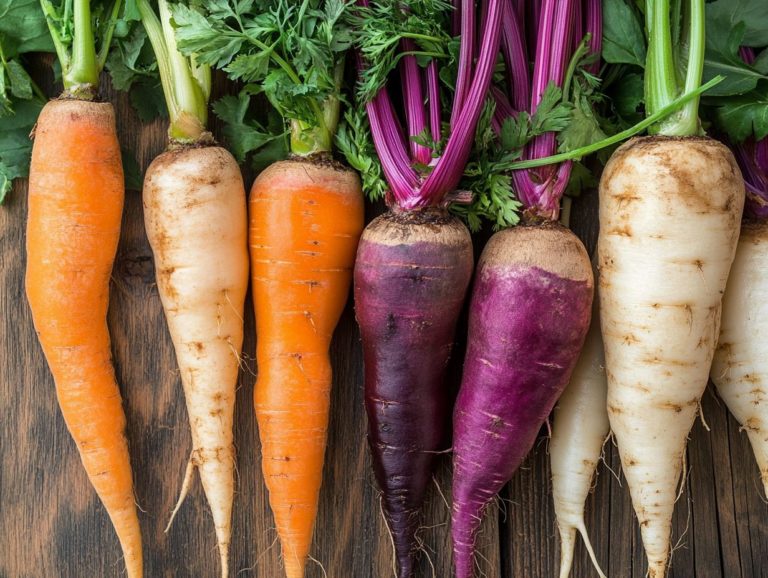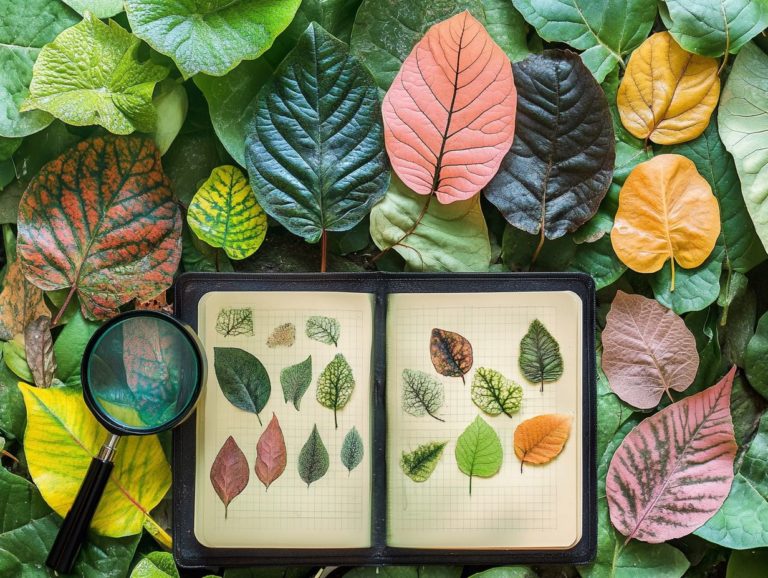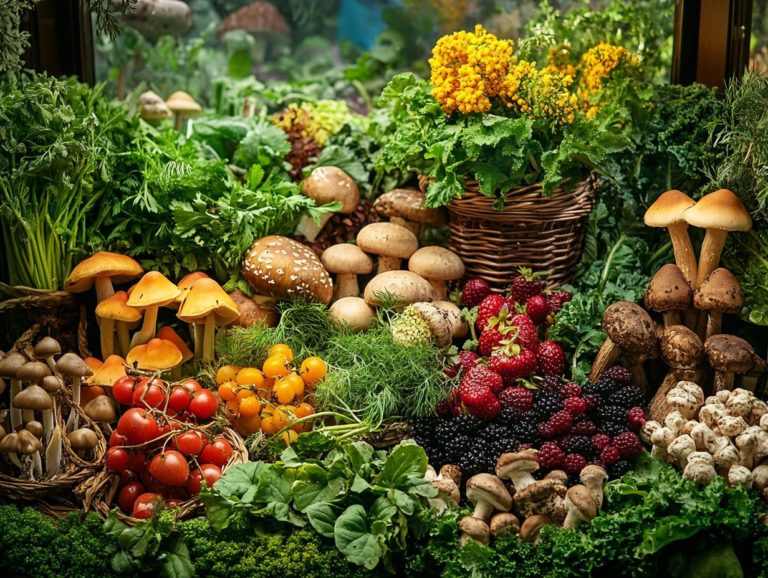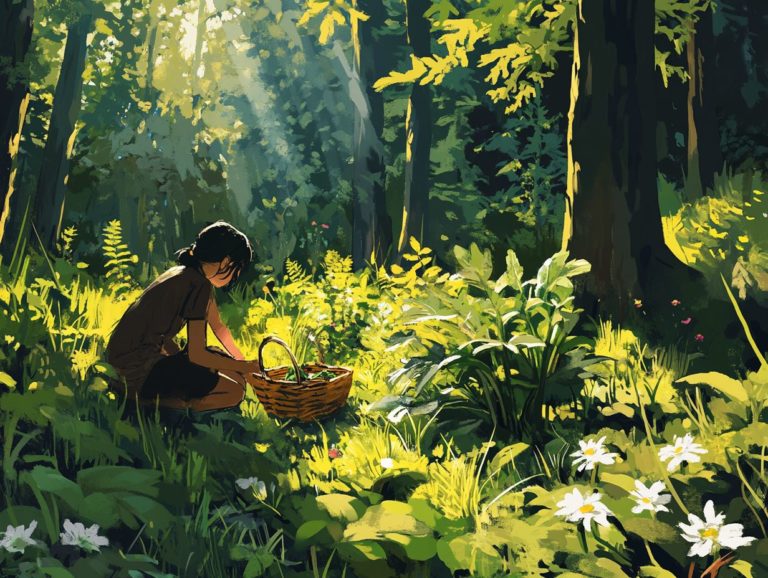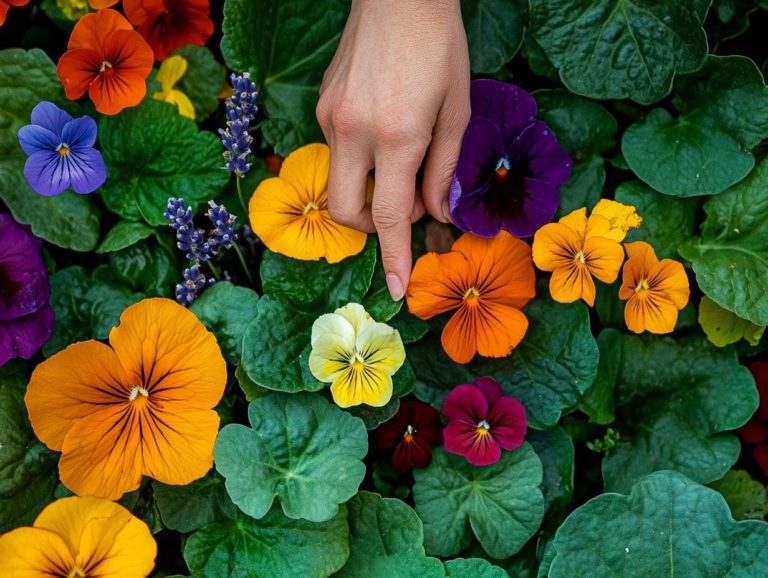5 Common Mistakes When Identifying Mushrooms
Identifying mushrooms can be thrilling! However, it comes with potential pitfalls. Many enthusiasts fall into common traps that lead to misidentification, which can have serious consequences, especially concerning the dangers of toxic mushrooms.
This article delves into five prevalent mistakes, ranging from over-reliance on visual cues to the often-overlooked significance of mushroom identification techniques. It highlights the dangers of misidentifying mushrooms and offers valuable tips to enhance your identification skills.
Whether you re a budding forager or a seasoned mushroom lover, this guide will help make your foraging adventures safe and fun!
Here are some crucial points to remember for safe mushroom foraging:
Contents
- Key Takeaways:
- 1. Relying Solely on Visual Identification
- 2. Not Checking for Spore Print Color
- 3. Not Consulting a Field Guide or Expert
- 4. Not Considering Habitat and Growing Conditions
- 5. Not Knowing the Difference Between Toxic and Edible Lookalikes
- What Are the Dangers of Misidentifying Mushrooms?
- What Are the Key Features to Look for When Identifying Mushrooms?
- How Can One Properly Document and Preserve Mushroom Specimens?
- What Are the Most Common Misidentified Mushrooms?
- What Are the Best Practices for Safely Harvesting and Consuming Wild Mushrooms?
- How Can You Improve Your Mushroom Identification Skills?
- Frequently Asked Questions
- What are the most common mistakes people make when identifying mushrooms?
- How can I avoid misidentifying a poisonous mushroom as edible?
- Why is it important to properly examine all identifying characteristics?
- Is it safe to rely on internet sources for mushroom identification?
- Why is it important to have proper knowledge and training before picking and consuming mushrooms?
- What are some safety precautions to follow when identifying mushrooms?
Key Takeaways:
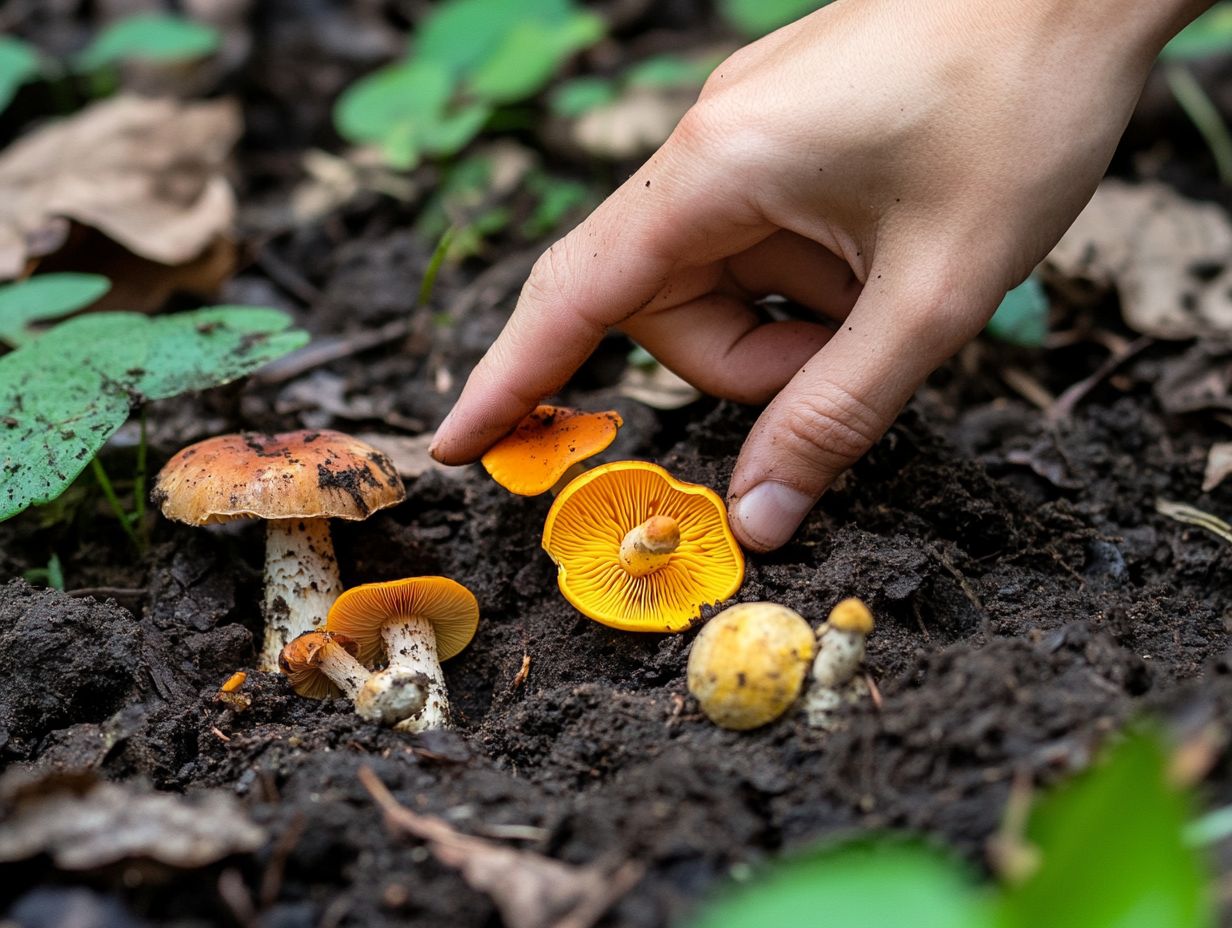
- Don’t solely rely on visual identification when identifying mushrooms; consider other important factors such as spore print color, habitat, and expert guidance.
- Always consult a field guide or expert when identifying mushrooms to ensure accuracy and avoid dangerous misidentifications.
- Knowing the difference between wild edible mushrooms and their toxic counterparts is crucial for safely harvesting and consuming wild mushrooms.
1. Relying Solely on Visual Identification
Relying solely on visual identification of edible mushrooms can lead you down a treacherous path of misidentification and potentially dangerous outcomes, particularly when it comes to distinguishing safe mushrooms from their poisonous counterparts. Experts like Michael Simpson in British Columbia emphasize that mastering proper mushroom education requires a nuanced understanding of their characteristics think mushroom form, growth patterns, and the habitats of various species. Not paying attention to these details risks your safety.
Even traits that seem innocuous, such as color or shape, can differ dramatically among species, leading to dangerous assumptions. Anecdotal evidence from seasoned foragers frequently highlights near-misses that occurred simply because they relied on misleading visual cues.
Mycologists stress that education is key. Grasping the intricacies of mushroom gills, spore print, and mushroom habitats can dramatically enhance your identification skills. Research shows that with proper training, individuals become far more adept at discerning edible varieties from their toxic counterparts an essential skill that can significantly reduce the risks associated with foraging.
2. Not Checking for Spore Print Color
Failing to check the spore print color is a critical oversight that can lead to the misidentification of mushroom species and a dangerous disregard for mushroom toxicity. To avoid such risks, be aware of the 5 signs of edible vs. poisonous mushrooms.
This detail in mushroom identification is vital; many wild mushrooms possess distinct spore print colors that stand in stark contrast to their toxic relatives. For example, the spore print of the common edible mushroom, Agaricus bisporus, typically showcases a rich brown, while the infamous Amanita phalloides produces a white spore print a clear warning sign.
Also, pay attention to the vibrant red spore print of the edible Chanterelle, which stands out dramatically against the dark, nearly black spores of its poisonous doppelg nger, the Jack-o -lantern mushroom, often associated with the Amanita family. Recognizing these variations not only bolsters your safety but also elevates your foraging experience to new heights.
So grab your field guide and get ready for an adventure in mushroom foraging!
3. Not Consulting a Field Guide or Expert
Not consulting a field guide or expert during mushroom foraging can significantly heighten your risk of harvesting toxic mushrooms. Proper mushroom foraging knowledge is essential for safe practices.
This is where reliable field guides and expert advice become essential resources for anyone diving into the fascinating world of fungi and mushroom education. Organizations like the North American Mycological Association (NAMA) and local mycological societies offer valuable workshops and resources that help both beginners and seasoned foragers grasp the nuances of different species.
Engaging with trained mushroom experts allows you to gain deeper insights into the ecological aspects of mushrooms, enriching your overall mushroom foraging experience.
Local governmental agencies, such as the U.S. Forest Service, often provide educational materials that promote safe practices. This ensures you can indulge in your passion while minimizing potential dangers.
4. Not Considering Habitat and Growing Conditions

Ignoring mushroom habitats and growing conditions can put you on a risky journey in mushroom identification. Various species of fungi thrive in specific ecological settings, which dramatically influence their characteristics.
Understanding the nuances of different mushroom habitats be it forests, meadows, or wetlands is essential for both enthusiasts and foragers. Each environment offers its unique blend of soil composition, moisture levels, and plant life, all of which can either promote or hinder mushroom growth.
For example, certain varieties, like morels, prefer disturbed lands or areas with particular tree species, while others, such as chanterelles, often flourish in coniferous forests.
The importance of ecology research cannot be overstated; it provides you with invaluable insights into the environmental conditions that govern mushroom ecosystems and distribution. This knowledge ultimately guides your journey into the intricate world of fungi, leading to more fruitful foraging experiences.
5. Not Knowing the Difference Between Toxic and Edible Lookalikes
Failing to discern between toxic and edible lookalikes can lead to grave consequences for mushroom foragers, emphasizing the importance of comprehensive mushroom foraging knowledge.
Understanding the specific traits that set these mushroom species apart is essential for anyone who relishes the art of foraging.
Take, for example, the sought-after chanterelle; it s vital to remain vigilant about the toxic jack-o’-lantern mushroom that bears a striking resemblance to other mushroom types.
The chanterelle typically boasts a wavy cap with a delightful fruity aroma, while the jack-o’-lantern features a more vibrant orange color and sharply defined gills.
Even among edible mushrooms, you ll encounter regional differences that can be deceptive. Exercising caution such as cross-referencing multiple identification sources and seeking guidance from seasoned foragers can greatly minimize the risk of misidentifying these fungi.
What Are the Dangers of Misidentifying Mushrooms?
The dangers of misidentifying mushrooms are far from trivial; consuming poisonous fungi can expose you to severe health risks, including gastrointestinal distress, organ failure, and, in the worst-case scenario, death. It’s crucial to grasp this knowledge before embarking on your next foraging adventure.
You might experience a spectrum of mushroom symptoms, ranging from mild nausea and vomiting to more alarming issues such as liver damage or neurological impairment.
Consider the unfortunate incident involving a family in the Pacific Northwest who mistakenly foraged for wild mushrooms, convinced they were picking something safe to eat. Their error led to hospitalization after ingesting Amanita phalloides, more commonly known as the death cap.
This harrowing experience highlights the paramount importance of proper identification, mushroom safety, and a thorough understanding of various mushroom species. Even seasoned foragers can slip up, and those mistakes can carry dire consequences for their health.
Join a local foraging group today!
What Are the Key Features to Look for When Identifying Mushrooms?
When identifying mushrooms, focus on key features like mushroom gills, spore color, and various aspects of mushroom shape to differentiate between types.
Take note of mushroom gills. They can be free, attached, or descending, each configuration offering valuable clues for classification.
The cap shape is just as important. It can be conical, bell-shaped, or convex, affecting how you identify the mushroom.
Don’t overlook the spore print! Its color can range from white to vibrant shades, making it crucial for distinguishing similar-looking species.
If you want to improve your skills, check out field guides like “Mushrooms of North America.” Online platforms like iNaturalist offer valuable insights and visual references.
How Can One Properly Document and Preserve Mushroom Specimens?
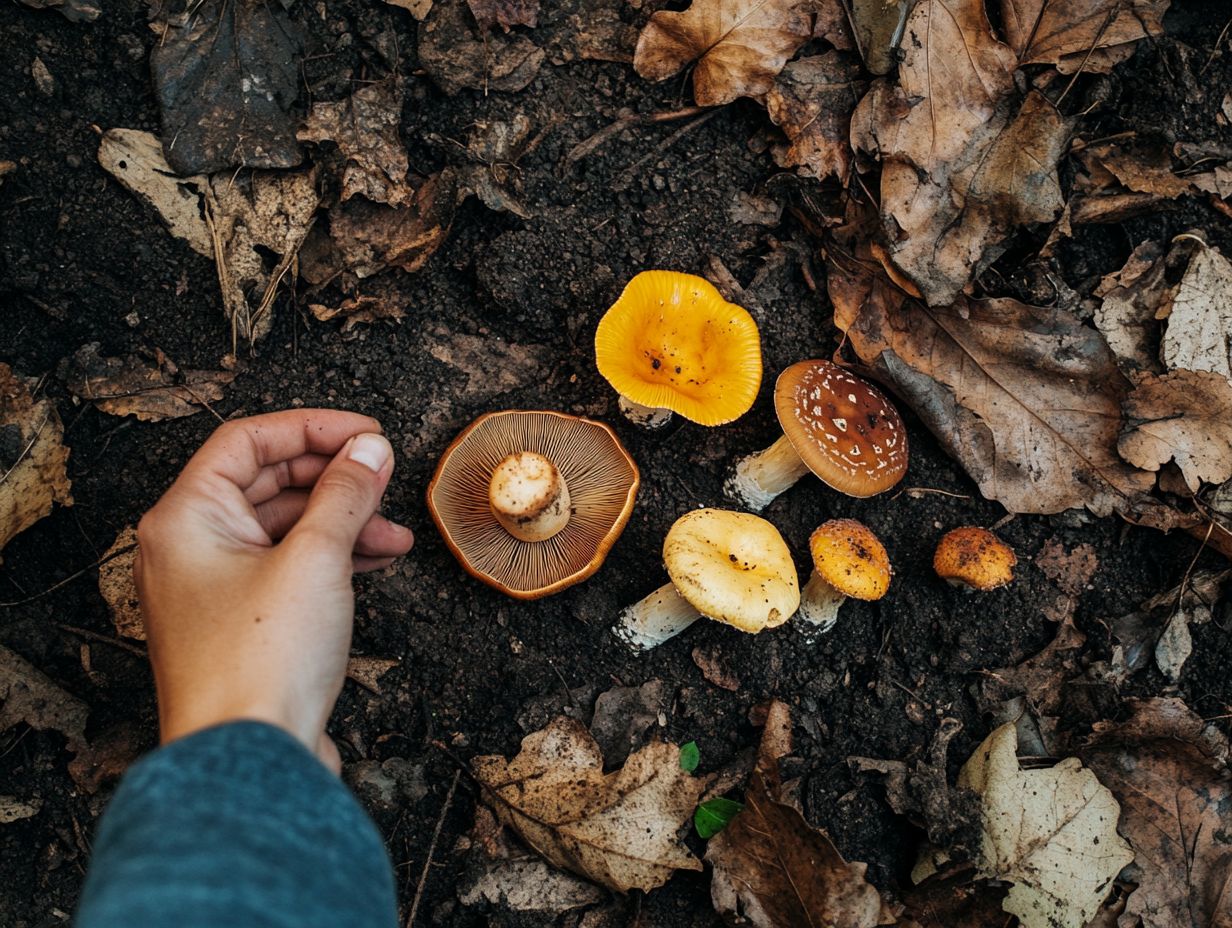
Properly documenting and preserving mushroom specimens is vital for advancing the study of mushrooms and ecological assessments. This ensures that mushroom identification remains precise and effective for various ecology projects.
By following systematic steps, you can significantly contribute to the field. Start by collecting specimens in a way that minimizes damage. Make sure to note their habitat and surrounding environmental conditions.
Once you’ve gathered your specimens, label each mushroom carefully with the date, location, and a description of the substrate. Employ preservation methods like drying or freezing to maintain their integrity for future studies. Air drying with the gills facing down is particularly effective.
Sharing your findings with local mycological groups can open doors to valuable insights and collaborative studies, deepening your understanding of biodiversity in various locales.
What Are the Most Common Misidentified Mushrooms?
Some of the most commonly misidentified mushrooms include popular edible varieties that have toxic lookalikes. It s essential to educate yourself on different mushroom species as a forager.
Take the delicious chanterelle, for example. It s often mistaken for the toxic jack-o’-lantern mushroom, as both share bright orange hues and a similar overall shape. Similarly, the enticing morel, a favorite in gourmet cooking, has a dangerous counterpart in the false morel, which can lead to severe illness. These mix-ups occur due to shared characteristics like color, shape, and habitat.
To avoid these pitfalls, pay attention to the details to spot the differences in stem structure and gills. Utilizing field guides or apps for verification can be a game-changer. Joining local mycology groups provides invaluable hands-on experience in safe identification practices.
What Are the Best Practices for Safely Harvesting and Consuming Wild Mushrooms?
Adopting best practices for safely harvesting and consuming wild mushrooms ensures both enjoyment and safety during your mushroom foraging activities.
To embark on a successful foraging adventure, start by familiarizing yourself with the habitats where edible varieties thrive, like wooded areas and grassy fields. Understanding the differences between safe and toxic species is crucial, so consulting reliable field guides or joining local mycological societies can be immensely helpful.
Understanding the nuances of mushroom safety is paramount. Even seasoned foragers remember to cook mushrooms thoroughly, as certain toxins can be neutralized with proper heat. By following these straightforward strategies, you will enrich your foraging experience and significantly reduce potential health risks.
How Can You Improve Your Mushroom Identification Skills?
Dive into the world of mushrooms! Improving your mushroom identification skills is achievable through dedicated mushroom education and engaging in university courses. You can also hone your identification techniques in the field.
Structured learning offers a wealth of resources that cater to various preferences and schedules. You can immerse yourself in practical workshops or explore online courses that provide interactive experiences and invaluable insights into mushroom biology and ecology.
If you prefer outdoor learning, field guides will be your trusty companions for on-the-spot identification, enhancing your foraging adventures. Joining local foraging groups and participating in community events not only presents networking opportunities but also nurtures a collaborative spirit among fellow mushroom enthusiasts.
These activities refine your skills and foster a deeper appreciation for the fascinating and diverse world of mushrooms and fungi.
Frequently Asked Questions
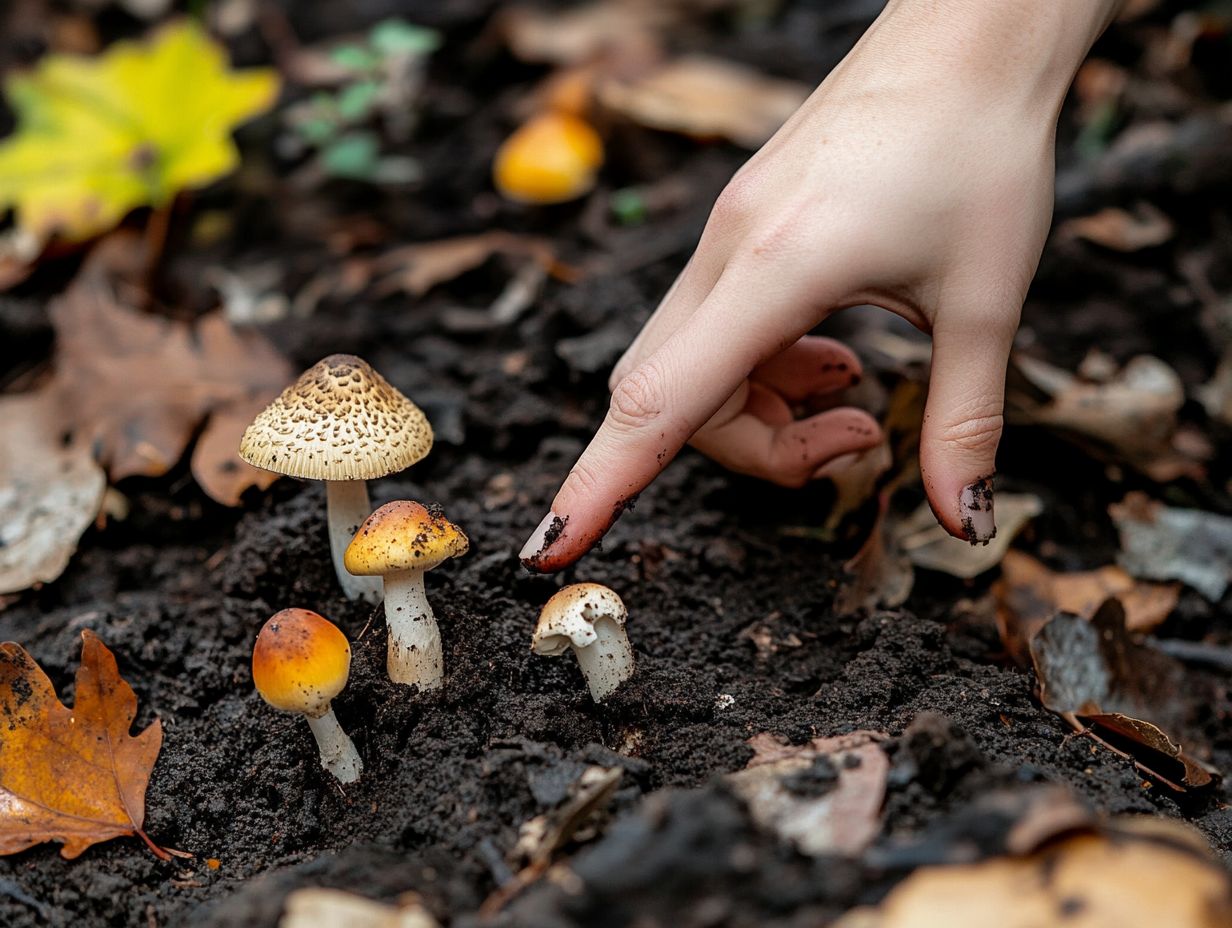
What are the most common mistakes people make when identifying mushrooms?
The most common mistakes in plant identification include misidentifying a poisonous species as edible, not properly examining all identifying characteristics, relying solely on internet sources for identification, picking and consuming mushrooms without proper knowledge or training, and not following safety precautions. To avoid these issues, refer to resources on common mistakes in plant identification.
How can I avoid misidentifying a poisonous mushroom as edible?
To avoid misidentifying a poisonous mushroom, never rely on one single characteristic. Always examine the color, shape, size, texture, and other identifying features before consuming a mushroom.
Why is it important to properly examine all identifying characteristics?
Identifying mushrooms based on one feature, like color or texture, can be dangerous. Many poisonous mushrooms can mimic edible ones, so examining all characteristics is crucial for safe and accurate identification.
Is it safe to rely on internet sources for mushroom identification?
No, it is not safe to rely solely on internet sources. Many websites may contain incorrect or outdated information. Without proper knowledge or training, it is easy to misidentify a mushroom and put yourself at risk.
Why is it important to have proper knowledge and training before picking and consuming mushrooms?
Mushrooms can be visually deceiving, and some poisonous species closely resemble edible ones. Ingesting a poisonous mushroom can lead to serious illness or even death, so proper knowledge and training are essential.
What are some safety precautions to follow when identifying mushrooms?
Safety precautions include wearing gloves while handling mushrooms, using a reliable identification guide, not consuming wild mushrooms without proper training, and always double-checking your identification before consuming. It’s also best to only pick and consume mushrooms from trusted sources.
Start your mushroom journey now!

